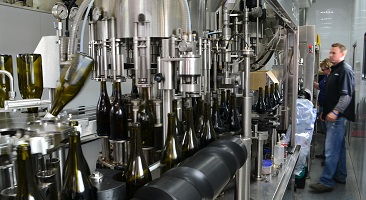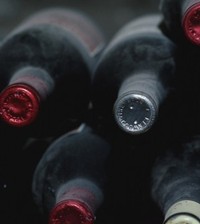Kuhlman Cellars Blog
Wine Blends and New Red Wines
Where did January go?!
I know I feel this way every new year, but we’ve turned around, took a breath, and have already flown into February! That’s exciting though because that means we’ve also enjoyed one of our favorite events: the Annual Super Bowl Tailgate party! That day was so much fun with wine and incredible food. And, we won the weather lottery - AGAIN - with stunningly perfect weather. It’s always risky in February in Texas, but we all adapt and do what we do.
Another reason I look forward to February: it’s time to think about our new vintage red wine blends! It’s an exciting and anticipatory time when we start talking about blends, volumes, and goals. It’s more enticing when Benedicte comes around with sample bottles and 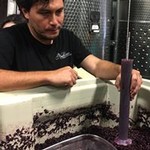 graduated cylinders.
graduated cylinders.
Our red winemaking process follows a general pattern: harvest in the fall to make red wine in individual lots from our different vineyards. Let the wine begin maturing in tank and barrel until February the following year, when unique terroir character becomes more evident. Bénédicte then begins her blending magic crafting the wines we’ve come to love as well as potential new. By the end of March, we typically settle on the blends. By June, the blending is typically complete and the wines then rest in barrel till bottling. Bottling is a long process guided by the wine’s maturation progress. Our first red bottling tranche typically happens in June, two years after harvest. A second bottling typically happens around 28 months post-harvest. We now have some wines which we are aging even longer to see how they develop in the barrel. Once bottled, the wines then rest anywhere from 4 to 12 months before release. It is a long process!
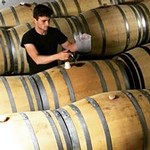 For 2017, we have some familiar red wines in barrel: Alluvé, Barranca, KanKar, Merlot, Zinfandel, Gypsum and Malbec-Merlot. Excitedly, we are producing several new wines, including: a Brunello Sangiovese, a Bordeaux Blend (Cabernet, Merlot and Malbec) as well as a Newsom Vineyard blend (Tempranillo, Cabernet, Malbec). These new wines are amazing, already complex, and teasing and testing the patience of us all. Bottling of these 2017 red beauties starts in June, but some of these wines might not be bottled for another couple of years. Patience!
For 2017, we have some familiar red wines in barrel: Alluvé, Barranca, KanKar, Merlot, Zinfandel, Gypsum and Malbec-Merlot. Excitedly, we are producing several new wines, including: a Brunello Sangiovese, a Bordeaux Blend (Cabernet, Merlot and Malbec) as well as a Newsom Vineyard blend (Tempranillo, Cabernet, Malbec). These new wines are amazing, already complex, and teasing and testing the patience of us all. Bottling of these 2017 red beauties starts in June, but some of these wines might not be bottled for another couple of years. Patience!
We don’t yet know the blends for 2018… ask us in a couple of months. We do know the Brunello will in the line up along with our regulars. What else awaits? We will just have to wait and see… there is no speed in winemaking, just the careful cadence of nurturing the vineyard and wine.
See you at the estate soon!
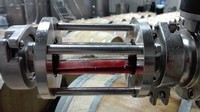
2019 Winter Pairing Menu
Welcome to 2019! Hard to believe we are already in January 2019. I know it is always this way as we wonder where last year went and what is in store for the new year. With the start of the new year, it is also time to debut the new 2019 Winter Pairing menu.
We rotate the menu every three months to keep things fresh, local and seasonal. Besides, it's always neat to 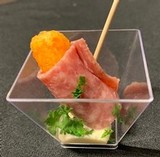 anticipate and then experience what new and different ideas Chef Cook has for us to enjoy. This menu is no different. To provide a little bit of a spoiler, we get to enjoy puffed Cheetos... wrapped in salami and dipped in an incredible avocado aioli paired with the 2016 Texas High Plains Merlot. Chester will be proud to see his snack elevated in ways unexpected!
anticipate and then experience what new and different ideas Chef Cook has for us to enjoy. This menu is no different. To provide a little bit of a spoiler, we get to enjoy puffed Cheetos... wrapped in salami and dipped in an incredible avocado aioli paired with the 2016 Texas High Plains Merlot. Chester will be proud to see his snack elevated in ways unexpected!
We are sometimes asked why we go through the effort to provide wine and food pairings. The answer is two fold: First, in our opinion, wines are best experienced when surrounded with friends, food and family. They facilitate community and conversation. Gathering around the table is the foundation of our food culture and traditions. We find ourselves connecting and reflecting. Wine helps us slow down and appreciate the bounty in our lives.
The Kuhlman Cellars food pairing tasting helps promote connections and relaxation. We sit at the tasting table where all are welcome. We find ourselves talking, laughing and sharing with friends new and old. It is amazing
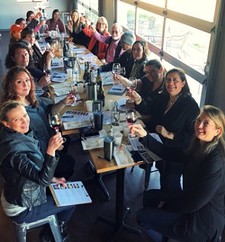
how many times new friendships are made or old ones are rediscovered by happenstance in the tasting room. That is what it is all about! We are pleased to facilitate this experience and have our wines be part of something special.
Second: growing and making wine takes a long time. Our red wines age around 30 months between harvest and release. KanKar, one of our flagship wines, takes about 38 months from harvest to release. So, let's not be in a hurry to slam down a wine-shot and race down the road. Instead, let's slow down, sit down, relax and savor. It is worth the effort.
The new menu will run until the end of March. This gives you plenty of time to find a day to reserve your tasting at the estate taste the wine and food bites. Don't forget, we also list out all the past pairing menus on the website, should you want to remind yourself of prior bites and perhaps new ideas for your own culinary adventure!
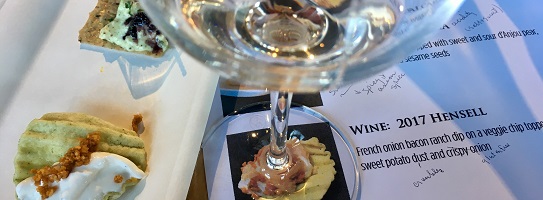
See you at the estate soon.
First Freeze of 2018!
 23* on November 14 brought the 2018 viticulture year at our three Fredericksburg, Texas vineyards to a fast frozen end!
23* on November 14 brought the 2018 viticulture year at our three Fredericksburg, Texas vineyards to a fast frozen end!
2018 was a challenging year in many respects, though really just another typical grape growing effort in Texas. I often describe Texas viticulture as one of survival. We have many risks to navigate: springtime frost, hail, disease, animal predation and "tropical rain events" (e.g., Hurricanes). Any year we harvest fruit is a success!
2018 started a little later than 2017, with the vines waking up in early March rather than late February. We avoided springtime frost and by April, growth was fast and abundant as the vines burst forth with the energy of Spring!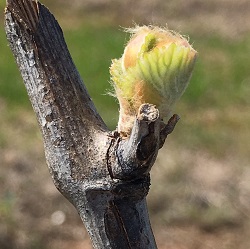
We had a very hot and dry growing season. The heat spike of June into July proved challenging as the vines struggle in excessive heat. The Estate Carignan, in prticular, seemed to suffer. The warm weather though, generally had the vines progressing through their maturation efforts quickly.
The estate fruit came in beautifully! We were pleased to get the first harvest off the Mourvedre in Block 1. This will be part of the estate Kuhlmanation Rose. We also welcomed the first ever harvest from our partner vineyard at Barons Creekside inside the city limits of Fredericksburg. This Petite Sirah vineyard is developing beautifully. Finally, we were relieved to harvest fruit at Cobb Family Vineyard again, after the racoon predation of 2017. We took the last fruit from the estate Carignan block 5 at the end of August. The fruit was beautiful. We harvested just in time too, as Texas weather rotated to a very wet early fall!
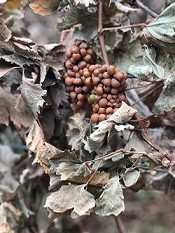 Keeping the vines healthy with all the rain was a challenge - the muddy vineyard made it tough to enter either on foot or tractor! Yet, the team managed and the vines made it through - and are looking great for next spring.
Keeping the vines healthy with all the rain was a challenge - the muddy vineyard made it tough to enter either on foot or tractor! Yet, the team managed and the vines made it through - and are looking great for next spring.
After the first freeze on November 14, the vines quickly went to sleep. As we walk the vineyards, we see the remnants of the season, including the occasional late developing cluster, now frozen in time. Texas viticulture isn't easy and it's never predictable. However, when successful, we are rewarded with distinctly unique, quality driven wines. We look forward to sharing the new vintage with you... but only when the wines are ready. For now, practice patience!
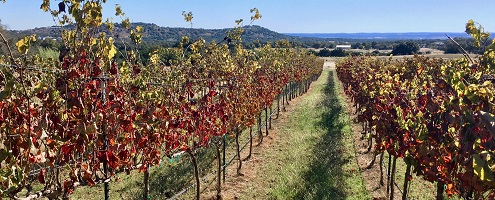
Roll Out the Barrel!
What is the first thing that comes to mind when you think of a dusty old cellar beneath a Chateau in France? What is the first thing people want to see when they tour a winery? The answer for most of us would be the wine barrel. Simply put, the oak barrel is one of the single most romantic things to observe in the cellar, they are equally as beloved in regards to winemaking. Barrels act as a vessel, a membrane between the wine and the oxygen-rich air outside of the barrel. These metal-hooped, toasted bunches of oak slats, call staves, are oh-so important to the art of making fine wine. Let us take a look into the world of wine barrels, and why they are an integral tool in the cellar.
Firstly, why barrel age a wine? A wine barrel acts as a porous barrier, allowing small amounts of oxygen transfer to occur over time. This aspect of barrel aging really helps to achieve structure and marriage of flavors in a wine. Second, it is very common to obtain flavors from a new oak barrel during its first use, typically within the first year or two of a barrel’s life. After such time, the barrel becomes what we call neutral, basically meaning it imparts little flavor into the wine, but the oxidative effect and additional tannins from the wood are still very much present.
There are several regions in which we harvest oak, but the two most common would be French and American oak. Each has their own unique personality and offers different characteristics to the wine housed within them.
 American oak- Harvested from oak in the warmer climate of the United States, this type of wood has looser graining which produces more aggressive flavor profiles. Baking spices, dill, vanilla and toasty flavors are often exuded from American oak.
American oak- Harvested from oak in the warmer climate of the United States, this type of wood has looser graining which produces more aggressive flavor profiles. Baking spices, dill, vanilla and toasty flavors are often exuded from American oak.
French oak- Harvested from the cooler climate of France, this type of wood offers tighter graining which produces more gentle flavor profiles. Gentle notes of vanilla and toast can be expected from French oak.
What about tannins? In wine, tannins come from the skins, seeds (called pips), and the stems of the grape clusters. Did you know tannins also are imparted from the oak barrels? Typically we perceive phenolic tannins from the fruit on the front palate, while the tannin compounds from the oak barrels are often sensed on the back palate. Tannins in general are perceived as astringency all over the mouth, and add a ton to the structural mouth-feel of a wine.
Next time you are in a tasting room and are admiring the oak barrels, try and remember how much they add to the finished product in your glass. Let us also give a shout-out to the people that put in the time and effort that went into making a wine barrel by hand.
Vina Vita, my friends!
Better With Age?
The holidays are a time when giving and receiving can result in a nice stash of wine accumulating in your cellar. If hosting a holiday party, chances are a guest will bring a bottle of wine or Champagne as a thank you gift. Santa may deliver an intriguing bottle of your favorite varietal with a note to not open until Christmas… five years later. Rather than let your yuletide bounty of bottles sit on the kitchen counter, here are some tips for storing the gift of wine all year long.
Cellaring: Why?
Only 1% of the world’s wines are meant for “long term” storage. The other 99% is meant for consumption between immediate and up to 10 years. During that time, the way a wine is stored can help preserve the integrity of the product and encourage the long-term chemical reactions happening inside improving it with age.
Wines biggest ‘frenemy’ is Oxygen. Oxygen allows wine to ‘open’ when uncorked, allowing a wide range of aromatics and flavors to emerge. Prematurely introducing oxygen for long spans of time degrades and ‘spoils’ the wine. Wines with a high level of natural acidity help slow the oxidation process. . When you cut open an apple, the flesh begins to brown very quickly due to oxidation. Wine undergoes a similar ‘browning’. High natural acidity in wine helps slow the oxidation process much like lemon juice stops oxidation in fruit.
Tannin levels also help prevent oxidation. Tannins act like a “shock absorber” to process oxygen in a way that allows other chemical complexities to not bear the full brunt of exposure. Tannins are primarily gained from extended contact with the seeds of the grape and barrel aging. Storing wine properly allows tannin chains to be “used up” or broken, giving aged wine a softer, more nuanced body. White wines do not have the same exposure to the seeds and barrel age resulting in low tannins and a generally a poor candidate for long term storage. Try to consume white wines within three years of the date on the bottle for best results.
Cellaring: Where?
Every collector dreams of stepping into a stone-walled underground cellar lined with cedar racks nestling bottles like sleeping baby bats in a cave. Sadly, this romantic version of the perfect cellar is simply not reality for everyday urban living. A functional, practical cellar for storing wine can be incorporated into any home. These four simple rules will help save your wines from spoilage:
Find a cool place: Ideally wines should be cellared at 65 degrees. But here in Texas, following the rule of not exceeding 75 degrees is more practical. Find a spot that provides a stable temperature level and avoid wild heating and cooling fluctuations. Wines stored in excess of 80 degrees can ‘bake’ in the bottle causing heat damage.
-
Find a dark place: UV light rays are damaging to wine. Find a shaded space away from direct sunlight. Green or brown or bottles act as a UV filter, but prolonged UV exposure will harm the liquid in the bottle.
-
Bad Vibes: There are tens of thousands of complex chemical reactions happening in a single bottle of wine. Vibrations can speed up or deter these reactions from happening. Keep your wine collection away from heavy machinery like washers and driers, climate control systems and vehicles.
-
Going Sideways: Bottles should be stored on their side to maintain contact between the liquid and natural cork. Because cork is porous, it can contract when dry and allow unwanted oxygen into the bottle. For this same reason, don’t allow corks to dry out. Keep your wine in a place where fresh, humid air can maintain the natural sponginess of cork.
Navigating the Wine Aisle
One item not on the label of a bottle is how long it should be stored for. Price point can be an indicator of how long a wine can sit before consumption. The majority of wines that price under $30 are meant to be drunk within 1-5 years after the vintage date. Wines between $30 to $100 are meant to age for 5-10 years of the vintage date, though there are many exceptions. The quality of the bottle and cork can offer subtle insight as to whether the winemaker chose to invest in the longevity of the juice.
Keep in mind that long term aging is not a benchmark for quality. Many highly praised wines are not meant to age past 10-20 years; the chemical composition simply does not hold up over time. The lack of prolonged cellaring possibilities does not impact the quality of a wine consumed within its proper stored lifetime.
National magazines and wine websites often note wines with the potential for long-term storage. When looking for a wine gift (or a gift for yourself) with delayed gratification in mind, consult these resources so you can buy now and enjoy later. If you are looking to shop for local this holiday season consult The Texas Wine Journal for guidance with Texas grown and produced wines. The Journal offers ratings and descriptions compiled from a panel of professional sommeliers after tasting the wines blindly by category. You can find more information about the journal at TexasWineJournal.org. Happy Holidays and safe imbibing!
Kuhlman Wines that are expected to age:
2012 Merlot: expected to show improvement for 5+ years, assess the progress in 2017
2012 Texas Red: expected show improvement for 5+ years, assess the progress in 2017
2012 Barranca: expected to age gracefully from 5-10 years
2012 KanKar: expected to age gracefully from 5-10 years
2015 Winter Wine Pairing Dinner
We held our first wine pairing dinner on January 31st - what an incredible Vina Vita event!
Chef Chris Cook, the co-founder of the San Antonio Chef Cooperatives, delivered an incredible multi-course dining experience filled with creative flavors, textures and beautiful presentations. Each course was perfectly paired with a different Kuhlman Cellars wine resulting in gastronomy harmony!
To match the elegance of the food, the dining experience was further heightened by holding the reception in our production and barrel facility and dining in the tasting room. Of course, our awesome team was there to ensure each guest was served and attended to without want of anything.
We intend to offer these Pairing Dinners quarterly as we rotate the wine tasting pairing menu with the season. Therefore, please watch for the next dinner in April when we announce the 2015 Spring Pairing menu.
I’ll wrap up now, but please enjoy the short video and selected pictures from the event.
Vina Vita!
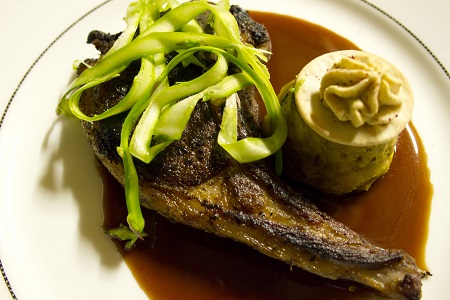
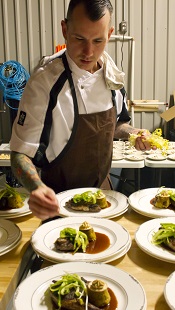
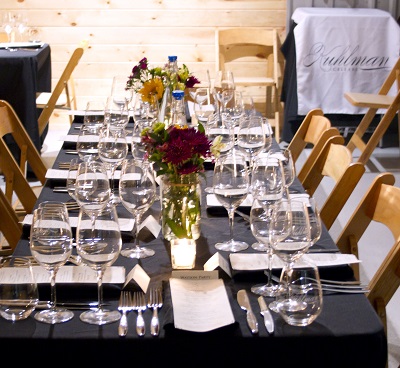
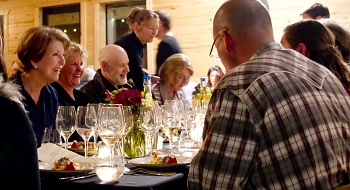
Fall Red Bottling!
It was a team effort as we came together to bottle three new wines yesterday, the first bottling run in our new facility! 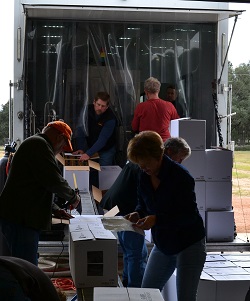
After a couple of years working with these wines, it really feels great to have them now safely snug in their bottles where they can rest until time for release. We bottled three wines:
- 2012 Texas Merlot, Texas High Plains
- 2012 Barranca, Sonoma County
- 2012 KanKar, Sonoma County
These wines are all uniquely beautiful and we will tell you more about them in the coming weeks. For now, we can share about the Texas Merlot: The Texas Merlot is a very nicely balanced red and is the same Merlot which forms the backbone of the 2012 Texas Red. We expect to release this wine first among the three. Unfortunately, we only bottled about 40 cases, and will only be releasing about 30 cases. Therefore, this special wine will first be allocated to the wine club and if any remains after their allocation period, we will offer it in the tasting room. As a teaser, please take a look at the beautiful label I've posted below!
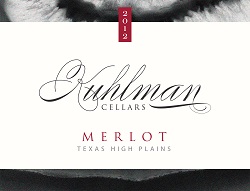 This bottling run is also special for us, as it is the first bottling done at our new production facility. We backed up the bottling truck and everything worked perfectly! Bottling is a fun, but tiring day – we start with the wine ready in the tank(s) and cases of new, empty bottles. Then, everything progresses through the bottling truck and then the bottled wine with labels, corks and foils all perfectly applied come out the other side. Viola!
This bottling run is also special for us, as it is the first bottling done at our new production facility. We backed up the bottling truck and everything worked perfectly! Bottling is a fun, but tiring day – we start with the wine ready in the tank(s) and cases of new, empty bottles. Then, everything progresses through the bottling truck and then the bottled wine with labels, corks and foils all perfectly applied come out the other side. Viola!
The important part of bottling is having the patience to let the wine rest sufficiently before release. This is sometimes the hardest part, because everyone is so excited to have it “finished” and the bottles all look so pretty and ready to go. But you have to wait and let the 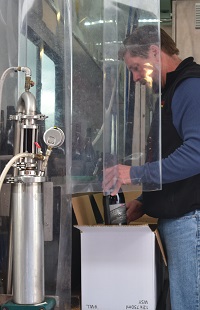 wine recover from the bottling process—it doesn’t like to be pumped around, pushed through nozzles, exposed to oxygen and then sealed in the little bottle space!
wine recover from the bottling process—it doesn’t like to be pumped around, pushed through nozzles, exposed to oxygen and then sealed in the little bottle space!
Patience, patience, patience.
Stay tuned for the release announcements.
